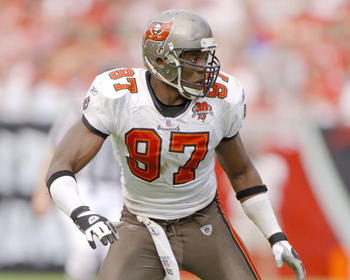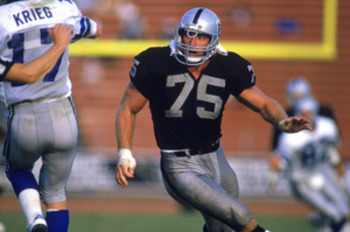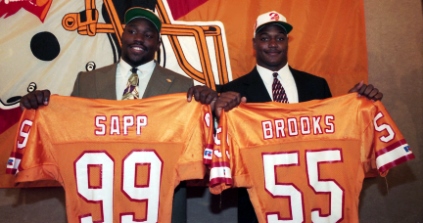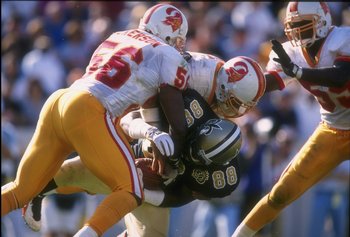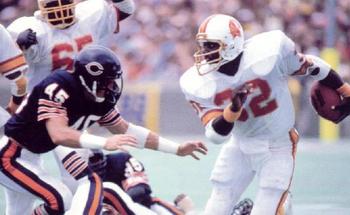@HighwayToHall
Warren
Sapp loves to talk. One of his latest outbursts is his argument that Simeon
Rice was better than Michael Strahan. As we in the Highway to Hall like to
debate such statements, let’s analyze this one.
First, in
fairness to Mr. Sapp, let’s review his actual statement:
“For all
of the people who are not historians of the football as I am, Michael Strahan
started his career at right defensive end in New York
Now, let’s
take a look at Strahan’s career and whether Sapp’s assessment is accurate.
Strahan
was drafted by the Giants in the 2nd round of the 1993 NFL Draft out
of Texas Taylor
If Strahan
was a bust, it doesn’t make a lot of sense to offer him a five-year contract.
Furthermore, Strahan’s rookie season was mostly lost due to injury, so his 12
sacks were totaled in 2 seasons. It was at this point that the Giants moved
Strahan to the left side, but it was not because he was a bust.
In the
1996 NFL Draft, the Giants used its first round pick (number 5 overall) on Oklahoma Oklahoma
It is this
last issue that received the most publicity. Jones was blind as a result of a
birth defect that was not detected until his freshman year of college. A doctor
supposedly corrected the problem in his senior year by performing a cornea
transplant. Unfortunately, he suffered several post-surgical complications,
which resulted in multiple laser surgeries. All of these issues led to slow
development.
Nonetheless,
on the day Jones reported to training camp, Strahan was moved to left defensive
end, a move he did not care for. "If somebody asked you to cover the Jets,
would you be upset?" Strahan asked reporters after the switch. “Of course
I was upset.”[2]
Head Coach Dan Reeves stated the move was experimental, apparently bothered by
the appearance that they handed a starting position to a rookie on his first
day.[3] In Strahan’s words, "The reason they
gave me was, they feel we don't have another defensive end they think can
handle left defensive end. And they want to leave (Robert) Harris inside. And
being that (left end) is the strong running position, that's where they wanted
the most experienced, or the best defensive end."[4]
Strahan
did not want the move to be strictly experimental. He said if they planned to
flip-flop him, he would rather move permanently so he could learn the new
position. "I had two choices," Strahan explained. "I could have
been upset about it and said, 'You know what? I have one more year here. I need
to play well this year, so I'm not moving because I don't want to be screwed
up.' Being that I want to win some games and ultimately I want to play, I'm
going to move there and I'm going to try it."[5]
This
team-first attitude came as no surprise to those who know Strahan. According to Strahan’s college coach,
“Strahan could have had had 25 or 30 sacks if we’d let him just rush. But he
sacrifices his sacks for the team. He’s the consummate team player. If you need
him to cover a running back, he does that. If you need him to be on the field
goal team, he does that. He also will take out blockers so others can make
tackles."[6]
This is in
stark contrast to Simeon Rice, who was criticized throughout his career for
being a selfish player. As stated earlier, Simeon Rice was selected in the same
draft as Cedric Jones. Some of the draft reviews of Rice were less than
glowing. “The Big Ten's all-time sack leader, potentially the next
Bruce Smith, if only he would grow up. He was being touted as the No. 1 overall
pick last season until he fell asleep against Penn State and now will probably
be taken behind teammate Kevin Hardy, who can get to the passer quicker.”[7]
Another preview described him as a “Gifted pass-rusher sure to go early in draft. .
. . Set Big Ten record of 44 1/2 career sacks. . . . Nothing special against
the run. . . . Some analysts believe he doesn't always play to his potential.”[8]
The
Arizona Cardinals selected him 3rd overall, one spot before the
Baltimore Ravens selected future Hall of Famer Jonathan Ogden. Head Coach Vince
Tobin said, “[W]hat we decided is that an offensive lineman can only help you
not lose a game; a pass-rusher can win a game for you with one play.”[9] In
other news, Tobin was fired 7 games into the 2000 season with a 28-43 career
record.
Although
the Cardinals only won 7 games in Rice’s rookie campaign, he did tie the then
NFL rookie record (held by Leslie O’Neal) with 12.5 sacks on his way to earning
the NFL Defensive Rookie of the Year Award. Both Rice and the Cards regressed
in his second season in which his sack total fell to 5 and the Cards sunk to
4-12. The Cardinals reached new-found success in 1998, however.
Prior to
Rice’s arrival, the Cardinals had not reached the playoffs since 1982 and had
not had a winning record since 1984. That changed in 1998 when the Cards
finished 9-7 and earned a wild card berth. Although the Cards defense finished
24th in yards and 21st in points that year, the defense
was pivotal down the stretch. The Cards sat at 6-7 after a loss to the New York
Giants on December 6, but reeled off 3 consecutive victories to finish the
season. They defeated the Philadelphia Eagles (20-17 in OT), New Orleans Saints
(19-17), and San Diego Chargers (16-13).
Of course,
the Eagles (3-13), Saints (6-10), and Chargers (5-11) all finished with losing
records. And the quarterbacks in these epic battles were Koy Detmer, Kerry
Collins, and Craig Whelihan. Whelihan in particular struggled, finishing 16 of
40 for 214 yards and 4 interceptions, all to Kwamie Lassiter. Despite facing
these illustrious quarterbacks, the Cards were gouged on the ground giving up
141 yards on 30 carries to Duce Staley (Eagles) and 127 yards on 23 carries to
Terrell Fletcher (Chargers). But they got the necessary wins, and then upset
the Dallas Cowboys in the 1st round of the playoffs 20-7.
Rice
finished the 1998 season with 10 sacks. In 1999, Rice improved his total to
16.5, earning his first Pro Bowl selection and being named 2nd Team
All-Pro (behind Kevin Carter and Jevon Kearse). The Cards did not have the same
success, however, slipping to 6-10. After the season, the Cardinals used the
Franchise Tag on Rice, which led to a contract holdout and resentment between
the parties. After missing the first game of the 2000 season, Rice returned to
the lineup, and finished the season with 7.5 sacks in a 3-13 season wrecked by
injuries.
The Cards
used the Franchise Tag on Aeneas Williams following the 2000 season, which
allowed Rice to leave via Free Agency. One of the suitors at that time,
ironically, was the New York Giants, who were seeking a replacement for Cedric
Jones. On Tuesday, March 6, 2001 , Rice was wined and
dined by Michael Strahan himself.[10]
The Giants viewed Rice as a good fit because they had the number 2 ranked defense
in the NFL against the run but needed a pass-rushing right end, as Jones had
only 3 ½ sacks the previous season. Giants head coach Jim Fassel was an
assistant with the Cardinals when Rice was drafted, and indicated Rice would
respond in a winning environment, particularly one full of team-first veterans.[11]
It turns
out Fassel was correct. Rice needed a change of scenery, which he found in
Tampa. After the Giants signed Kenny Holmes, Rice signed with the Tampa Bay
Buccaneers, to join a defensive line that featured first round picks Marcus
Jones, Anthony McFarland, and future Hall of Famer Warren Sapp. Despite setting
a team record with 55 sacks in 2000, right defensive end Chidi Ahanotu
contributed only 3 ½. So an upgrade was needed. Rice signed a contract with no
signing bonus and only a $1-million base salary the first season (although the
overall terms of the deal were for 5-years and 34 million dollars). Rice bet on
himself and the gamble paid off.
As Bucs
defensive coordinator Monte Kiffin said, “We never had the pure speed rusher on
the outside at right defensive end. So you put (Rice) out there and make that
left tackle turn out, that leaves that left guard more man-to-man on Warren
Sapp.”[12]
Rice terrorized quarterbacks during his first 5 seasons in Tampa, recording
double-digit sack totals each year. He was named to 2 Pro Bowls, named 1st
Team All-Pro in 2002 and 2nd Team All-Pro in 2003, and helped the
Bucs make 3 playoff appearances and win a Super Bowl title. He totaled 4 sacks
in the Bucs 2002 playoff run, including 2 in the Super Bowl.
Rice was a
perfect fit. Tampa was a team that did not like to blitz. Their success hinged
on the front four’s ability to generate a pass rush. Rice was an integral part
of that. But he also developed other aspects of his game. According to one NFL
talent evaluator, “When Rice first got to Tampa, people were saying he was a
liability against the run and that he wasn’t interested in that part of the
game. To some degree that was true. But that’s not the case now. He’s gotten
much better against the run, Simeon has. I think their coach down there [Rod
Marinelli] has a lot to do with that. He really gets after those guys and he’s
made him more of a complete player.”[13]
Unfortunately,
defensive line coach Marinelli was named the head coach of the Detroit Lions in
2006. When Marinelli left, the wheels fell off. Rice appeared to lack
motivation to play, which led to the return of old criticism. “When things are
going well, when a team is winning, Rice is a delightful side dish. When the
defense is smothering opponents, when his sacks are coming with incredible
frequency, it is easy to laugh at his runaway bluster and admire Rice’s
ability…When a team is losing, however, when Rice has been reduced to a
bystander, he turns from character to cartoon. In those times, Rice looks like
a one-trick pony, a pass-rusher who observes while waiting for the game to get
around to third and 11. He is the $6-million man, and the urge is to check his
warranty.[14]
In 2006,
everyone appeared to have something to say about Rice. According to Strahan,
“If you just want to pay attention to the other stuff and just run up the
field, then you’re going to be Simeon Rice. You can get big numbers, but you
don’t have the respect of the defensive ends.”[15]
Former teammate Keyshawn Johnson chimed in, “All Simeon Rice does is rush the
passer. That’s it. If he doesn’t get to the quarterback, you can forget it. He
ain’t making any other plays.”[16]
Rice,
hindered by a shoulder injury, appeared in only 8 games for the Bucs in 2006,
recording 2 sacks. He was unceremoniously released prior to the 2007 season,
and appeared in 8 more NFL games before retiring (6 with Denver and 2 with
Indianapolis).
Rice
finished his career with 122 sacks (13th highest total since sacks
became an official statistic in 1982), 28 forced fumbles, and 475 tackles.
We left
Strahan above after his move to left defensive end. In twelve seasons on the
left side, Strahan totaled 129.5 sacks (141.5 overall), 20 forced fumbles (24
overall), and 753 tackles (854 overall). He was selected to 7 Pro Bowls, named
to 4 1st Team All-Pro teams, 2 2nd Team All-Pro teams,
and chosen a member of the All-Decade Team of the 2000s. He retired following a
Super Bowl title in the 2007 season.
Oddly, in
a 15-year career, the Giants only finished in the top 10 in yards allowed and
points allowed in the same season 3 times, including once during his rookie
season in which he saw little action. Contrast this with Rice whose defenses
achieved this feat his first 5 seasons in Tampa
Nonetheless,
it seems pretty clear that Sapp is off-base with his comments. But before we
conclude, let’s consider this idea that the left defensive end is an inferior
position to right defensive end. The right side tends to be the home of the
pass-rush specialist. The left side is different. “[Y]ou’ve got to be smart to
play on that left side. The left side sees a few more things, a little more
run.”[17]
Sapp seems
to indicate that defensive ends who can’t cut it on the right side, move to the
left side in a last ditch effort to save their careers. Is this true? Well, in
1994, the NFL released its 75th Anniversary All-Time Team, which
featured three defensive ends: Reggie White, Deacon Jones, and Gino Marchetti.
All three men were left defensive ends. I dare anyone to tell them they
couldn’t hack it on the right side.
Although
no discussion on Reggie White, Deacon Jones, or Gino Marchetti is necessary,
let’s take a brief look at White’s journey to left defensive end.
White was
a consensus All-American defensive lineman at Tennessee
In 1984,
the NFL held a Supplemental Draft of USFL players in an attempt to avoid a
bidding war on its players. The Philadelphia Eagles selected White with the 4th
pick overall, after Steve Young, Mike Rozier, and Gary Zimmerman. Playing
without White in 1984, the Philadelphia Eagles set a club record with 60
quarterback sacks. Right end Greg Brown was the second-leading sacker in the
NFC with 16, trailing only Richard Dent’s 17.5 in that category. Brown, who had
made the team in 1981 as a pass-rushing specialist, took over the starting job when Carl Hairston was injured during the 1983
seasons. Hairston was then traded to the Cleveland Browns before the 1984
season. Entering the 1985 season, Philadelphia had Byron Darby and Tom
Strauthers slotted at the left defensive end position. The Eagles were actively
pursuing the services of White, who, as stated above, was less than optimistic
regarding the USFL’s direction. Eventually, the Eagles bought out the final 3
years of White’s contract and inked him to a series of four 1-year contracts. White
came to the Eagles 4 games into the 1985 season. In his first game, against the
New York Giants on September 29, 1985 , White recorded 2.5
sacks and 7 tackles in a 16-10 overtime loss. His 13 sacks and 100 tackles in
13 games earned him NFL Defensive Rookie of the Year honors. The rest is
history.
Early on, White
was being compared to Hall of Famer Howie Long, another player who primarily
played left defensive end. According to White, “That’s the guy I want to be
compared to. The thing that impresses me about him is that he’s tough on the
run and the pass. That’s what makes a great defensive lineman. I wouldn’t want
to be compared to Mark Gastineau, for instance, because he’s real tough against
the pass only. He’s not as tough as Howie Long on the run.”[18]
Long seemed to share White’s sentiments, “Just one year, just once, I’d like to
spend a whole season doing nothing but going after the quarterback. I’d like to
see how many sacks I’d get. The guys out there, they don’t even know what it’s
like to try to stop the run.”[19]
It seems
Sapp is alone in his belief that right defensive end is a tougher position than
left defensive end. It’s nice of Sapp to stand up for Simeon Rice, a player who
was better than most fans probably remember. But he was a pass-rush specialist,
which necessitates he play on the right side. Strahan, on the other hand, was a
complete defensive player, better suited for the left side. Strahan will join
the NFL Hall of Fame as a member of the Class of 2014. Rice will spend many
years on the ballot, but he will never be named a finalist.
[1]
The Giants used its first round pick that year in the Supplemental Draft by
selecting quarterback Dave Brown.
[2] Meisel, Barry. “Strahan: Giants Run
End Around.” New York 1
Aug. 1996 :
93. Print.
[3]
"We're not giving anybody any job," Reeves said testily.
"They're going to earn their job."
[4]
Id.
[5]
Id.
[6]
Farmer, Neal. “TSU’s Strahan trades sacks for team defense.” Houston 1 Sept. 1992 : 6. Print.
[7]
Plaschke, Bill. “Rating the NFL Draft.” Los Angeles 19 Apr. 1996 . Available at: http://articles.latimes.com/1996-04-19/sports/sp-60299_1_nfl-draft.
[9]
Reisner, Mel. “Oddball Cardinal’s virtues rewarded: Rice earns top defensive
rookie honor.” Arizona 27 Dec. 1996 : 1C. Print.
[12]
Stroud, Rick. “With the table set, Rice pulls up a chair.” St. Petersburg 24 Mar. 2001 : 1C. Print.
[14]
Shelton , Gary .
“Earth to Sim. You there?” St. Petersburg 22 Oct. 2006 :
Gameday 1X. Print.
[16]
Smith, Katherine. “Add Keyshawn to List of Rice’s Critics.” Tampa 19 Oct. 2006 : Sports 5. Print.
[17]
Giants defensive coordinator Mike Nolan. Singelais, Mark. “End doesn’t think
that left is right for him.” The Times Union (Albany , NY 1 Aug. 1996 : C1. Print.
[18]
Judge, Clark. “Most teams don’t have a prayer against Eagles’ White.” Evening Tribune (San Diego , CA 12 Dec. 1985 : C20. Print.
[19]
Zimmerman, Paul. “Show of Appreciation.” 25 July 2000 . Available at
http://sportsillustrated.cnn.com/football/nfl/2000/halloffame/news/2000/07/25/drz/





